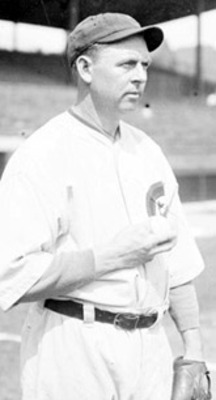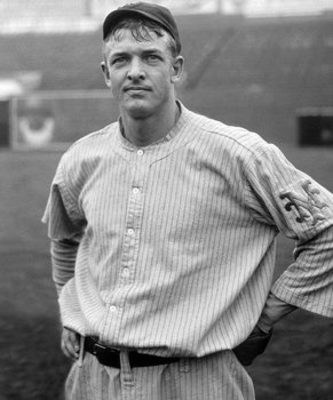On September 4, 1916, in the second game of a double header, Peter Centennial Mordecai "Three Finger" Brown faced off against Christy Mathewson for the final time. Mathewson, now with the Reds', was managing Cincinnati and had not pitched in weeks As a way to revive the good old times Christy decided to face off against Brown in Three Finger's last career game.
The two men were forever linked. The two best pitchers on the two best teams of the last decade. Their match ups were what made baseball the national past time. Mathewson was the leader, the shining beacon of what a ball player should be, the symbol of the New York Giants since the turn of the century. Brown was the quiet, reserved, unquestioned ace of the Cubs' dynasty.
Between 1903 (the start of World Series play) and 1916 (their last season as active pitchers) Brown and Mathewson had been the top two pitchers in the game. Their teams were the two best teams in the game. The Giants had won the National League five times (1904, 1905, 1911, 1912 and 1913) and finished second five other times. The Cubs had won the National League four times (1906, 1907, 1908 and 1910) and finished second three other times. Clearly these two teams were constantly battling for the top spot.
The Cubs hated the Giants and the feeling was mutual. You didn't need to look any further than the Fred Merkle debacle to find the raw nerve that was exposed. It was a wound that started as a minor scratch when McGraw took over the Giants and immediately brought a swagger to a team that had talent. At about the same time out west Frank Chance was taking over as manager of the Chicago Cubs and building a winner. The rise of the Giants to a powerhouse and the rise of the Cubs to a rival led to the inevitable collisions that created a heated rivalry.
The two pitchers would face each other a total of 25 times. Only once did the game end with neither getting a decision. The games were usually close, tense affairs and in 13 of those 25 games Mathewson came out on top. In the other 11 Brown came out on top. In one legendary game in 1905 Mathewson no hit the Cubs and won 1-0. His opponent, Brown, allowed only one hit, the game winning hit that scored the only run of the game.
This was a bitter rivalry but it was a rivalry with respect. These two would leave the yelling to Chance, McGraw and Evers. Both men were quiet men. Both men were humble men. Both pitched right handed. Both dominated the league but their upbringings were polar opposites.
Brown grew up in poverty. He once said he thought he was fortunate to "have a shoe on one foot and a rubber boot on the other" while he was growing up. He permanently damaged his hand in a thresher accident as a child, losing the tip of one finger. In a later accident he broke another finger giving him a deformed finger. Brown was forever known as "Three Finger" Brown but his team mates called him "Miner". Brown worked in the mines spending long hours in atrocious conditions with little hope of ever finding a better job. Brown was plain looking, a simple man.
Mathewson was born into a prominent family in Factoryville, PA near the Pennsylvania-New York border. His mother wanted him to be a preacher. He decided on going to college at Bucknell instead. A recognized athlete in both football and baseball, Mathewson excelled in every facet of life. His grades were good. He was known as the handsome man on campus. He attracted the most lovely ladies and he pitched for the Giants as a summer job in college.
The teams behind them on September 4, 1916 were not the ones that fans of the rivalry were used to seeing. Mathewson was now wearing a uniform that read "Reds" on the left side, not the usual interlocked "NY" fans were used to. Mathewson had been traded to the Reds in July. It was done by John McGraw with the understanding that Mathewson would be given the opportunity to manage the Reds, a favor for Mathewson from McGraw for all the years of loyal service.
The defense behind both pitchers was different. Instead of Fred Snodgrass, Fred Merkle, Art Fletcher and Roger Bresnahan, Mathewson had Hal Chase, Baldy Louden, Ivey Wingo and Emil Huhn. Instead of Tinker, Evers, Chance and Johnny Kling behind him, Brown had Vic Saier, Larry Doyle, Chuck Wortman and Art Wilson.
The pitches were not as sharp as the old days. Mathewson's famous fadeaway ball didn't fade quite as much as it used to and the ball that Brown used to break off didn't break quite as hard. This would not be a repeat of the combined one hitter from 1905. The two men were shells of their former glory. Both pitched all nine innings Mathewson allowed 15 hits, Brown allowed 19. Mathewson allowed eight runs, Brown allowed ten. Mathewson got the win, Brown got the loss. The crowd got the right to tell their children and grandchildren that they saw Matty vs Three Finger Brown for the last time.
TRIVIA QUESTION:
Starting at First base for the Reds behind Christy Matthewson was Hal Chase. What was significant about the relationship between Mathewson and Chase?
ANSWER TO LAST WEEK'S TRIVIA QUESTION:
The famous showdown between Grover Cleveland Alexander and Tony Lazzeri is often believed to be the way the 1926 World Series ended. But Alexander's strikeout of the rookie sensation was only the final out of the 7th inning. The Yankees still had six offensive outs to get back in the game. The score was still at 3-2 when Lazzeri struck out and the Cardinals left two men on base to finish the top of the 8th. The Yankees went in order in the bottom of the 8th and the Cardinals did the same for the top of the 9th. The Yankees had three outs left and they had the big bats coming up: Combs, Koenig, Ruth and Meusel. Combs and Koenig both grounded to third for the first two outs of the inning. Babe Ruth followed that with a walk to bring up the clean up hitter Meusel with the tying run on first. Ruth was deceptively fast for his body type and he knew that he had a better chance to score from second than he did from first if Meusel hit a ball in the gap. He also counted on the fact that no one expected him to steal. So on the first pitch to Meusel, Ruth took off for second. What Ruth didn't count on was the throwing arm of Bob O'Farrell, the Cardinals Catcher and NL MVP of 1926. Ruth was caught stealing and the World Series was over.
ANSWER TO LAST WEEK'S TRIVIA QUESTION:
The famous showdown between Grover Cleveland Alexander and Tony Lazzeri is often believed to be the way the 1926 World Series ended. But Alexander's strikeout of the rookie sensation was only the final out of the 7th inning. The Yankees still had six offensive outs to get back in the game. The score was still at 3-2 when Lazzeri struck out and the Cardinals left two men on base to finish the top of the 8th. The Yankees went in order in the bottom of the 8th and the Cardinals did the same for the top of the 9th. The Yankees had three outs left and they had the big bats coming up: Combs, Koenig, Ruth and Meusel. Combs and Koenig both grounded to third for the first two outs of the inning. Babe Ruth followed that with a walk to bring up the clean up hitter Meusel with the tying run on first. Ruth was deceptively fast for his body type and he knew that he had a better chance to score from second than he did from first if Meusel hit a ball in the gap. He also counted on the fact that no one expected him to steal. So on the first pitch to Meusel, Ruth took off for second. What Ruth didn't count on was the throwing arm of Bob O'Farrell, the Cardinals Catcher and NL MVP of 1926. Ruth was caught stealing and the World Series was over.




Thank you for the great lesson in baseball history. It is really something how the Giants and Cubs dominated the first decade of the NL. What is your theory on why they were so dominating? Was it the ability to identify talent? Was it a good manager? Did the players get along? (Well maybe not the Cubs infield).
ReplyDeleteI have no idea to the trivia question. Were they traded for each other? Did they both go to Bucknell. Did Matthewson take all his money to the Chase Bank?
TJD
I think the Cubs and Giants dominated the league for a little bit of each of the above reasons. The players didn't get along off the field but they were a cohesive unit on the field. McGraw and Chance were definitely the great managers of the day and they clearly had the best talent. As the two teams rebuilt and sent players off to other teams, those players began to play a major part in the success of the teams they went to. Johnny Evers was a big reason the Miracle Braves of 1914 won the World Series. Fred merkle, Chief Meyers and Rube Marquard played a major part in the 1916 Brooklyn Robins NL Championship and Merkle helped the Cubs reach the World Series in 1918. The A's of the first decade also had the same success and their players certainly contributed to other teams successes when they moved on. Jack Coombs went on to help the 1916 Robins. Eddie Collins helped the White Sox to the 1917 and 1919 World Series (as did Joe Jackson). Jack Barry helped the Red Sox to several World Series wins. Herb Pennock helped the Red Sox in seeral years and then the Yankees. Frank "Home Run" Baker helped the Yankees win their first few AL Championships. As these great Hall of Fame players moved from team to team the championships moved with them.
DeleteInteresting read! As far as you know, was this rivarly also heavily played out in the press? You wrote that they had a bitter but respectful rivalry, but I'm just wondering if the press took advantage for that to sell papers.
ReplyDeleteI'm going to guess that the relationship Christy and Hal was that they're related or that they share a birthday.
The rivalry was definitely played out in the press. The Cubs-Giants rivalry sold papers like crazy. The Cubs-Giants rivalry was essentially the birth of the sports news industry. The Merkle incident and the aftermath of that game sold papers for months.
Delete